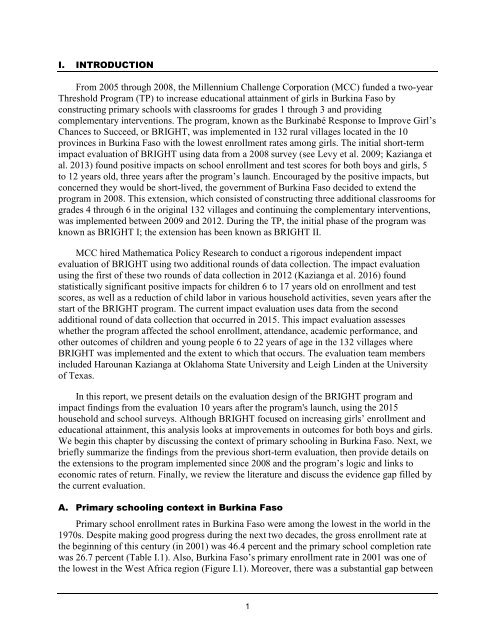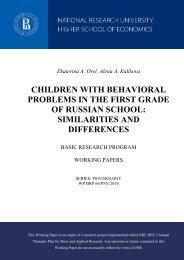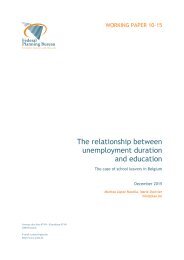Ten-Year Impacts of Burkina Faso’s BRIGHT Program
n?u=RePEc:mpr:mprres:2ecdd42bb503422b802ce20da2bf64b7&r=edu
n?u=RePEc:mpr:mprres:2ecdd42bb503422b802ce20da2bf64b7&r=edu
Create successful ePaper yourself
Turn your PDF publications into a flip-book with our unique Google optimized e-Paper software.
I. INTRODUCTION<br />
From 2005 through 2008, the Millennium Challenge Corporation (MCC) funded a two-year<br />
Threshold <strong>Program</strong> (TP) to increase educational attainment <strong>of</strong> girls in <strong>Burkina</strong> Faso by<br />
constructing primary schools with classrooms for grades 1 through 3 and providing<br />
complementary interventions. The program, known as the <strong>Burkina</strong>bé Response to Improve Girl’s<br />
Chances to Succeed, or <strong>BRIGHT</strong>, was implemented in 132 rural villages located in the 10<br />
provinces in <strong>Burkina</strong> Faso with the lowest enrollment rates among girls. The initial short-term<br />
impact evaluation <strong>of</strong> <strong>BRIGHT</strong> using data from a 2008 survey (see Levy et al. 2009; Kazianga et<br />
al. 2013) found positive impacts on school enrollment and test scores for both boys and girls, 5<br />
to 12 years old, three years after the program’s launch. Encouraged by the positive impacts, but<br />
concerned they would be short-lived, the government <strong>of</strong> <strong>Burkina</strong> Faso decided to extend the<br />
program in 2008. This extension, which consisted <strong>of</strong> constructing three additional classrooms for<br />
grades 4 through 6 in the original 132 villages and continuing the complementary interventions,<br />
was implemented between 2009 and 2012. During the TP, the initial phase <strong>of</strong> the program was<br />
known as <strong>BRIGHT</strong> I; the extension has been known as <strong>BRIGHT</strong> II.<br />
MCC hired Mathematica Policy Research to conduct a rigorous independent impact<br />
evaluation <strong>of</strong> <strong>BRIGHT</strong> using two additional rounds <strong>of</strong> data collection. The impact evaluation<br />
using the first <strong>of</strong> these two rounds <strong>of</strong> data collection in 2012 (Kazianga et al. 2016) found<br />
statistically significant positive impacts for children 6 to 17 years old on enrollment and test<br />
scores, as well as a reduction <strong>of</strong> child labor in various household activities, seven years after the<br />
start <strong>of</strong> the <strong>BRIGHT</strong> program. The current impact evaluation uses data from the second<br />
additional round <strong>of</strong> data collection that occurred in 2015. This impact evaluation assesses<br />
whether the program affected the school enrollment, attendance, academic performance, and<br />
other outcomes <strong>of</strong> children and young people 6 to 22 years <strong>of</strong> age in the 132 villages where<br />
<strong>BRIGHT</strong> was implemented and the extent to which that occurs. The evaluation team members<br />
included Harounan Kazianga at Oklahoma State University and Leigh Linden at the University<br />
<strong>of</strong> Texas.<br />
In this report, we present details on the evaluation design <strong>of</strong> the <strong>BRIGHT</strong> program and<br />
impact findings from the evaluation 10 years after the program's launch, using the 2015<br />
household and school surveys. Although <strong>BRIGHT</strong> focused on increasing girls’ enrollment and<br />
educational attainment, this analysis looks at improvements in outcomes for both boys and girls.<br />
We begin this chapter by discussing the context <strong>of</strong> primary schooling in <strong>Burkina</strong> Faso. Next, we<br />
briefly summarize the findings from the previous short-term evaluation, then provide details on<br />
the extensions to the program implemented since 2008 and the program’s logic and links to<br />
economic rates <strong>of</strong> return. Finally, we review the literature and discuss the evidence gap filled by<br />
the current evaluation.<br />
A. Primary schooling context in <strong>Burkina</strong> Faso<br />
Primary school enrollment rates in <strong>Burkina</strong> Faso were among the lowest in the world in the<br />
1970s. Despite making good progress during the next two decades, the gross enrollment rate at<br />
the beginning <strong>of</strong> this century (in 2001) was 46.4 percent and the primary school completion rate<br />
was 26.7 percent (Table I.1). Also, <strong>Burkina</strong> <strong>Faso’s</strong> primary enrollment rate in 2001 was one <strong>of</strong><br />
the lowest in the West Africa region (Figure I.1). Moreover, there was a substantial gap between<br />
1







